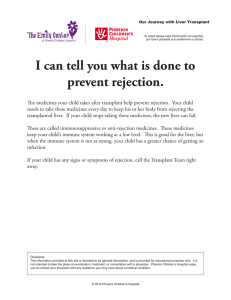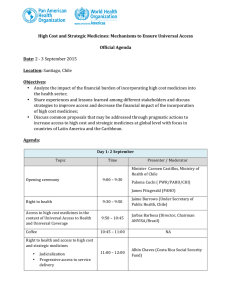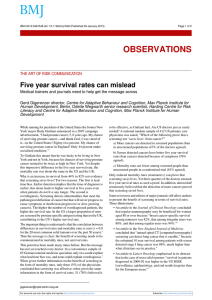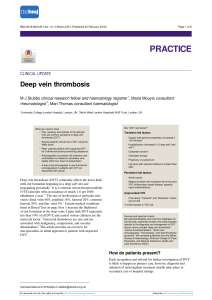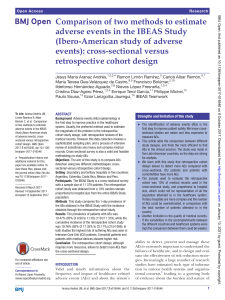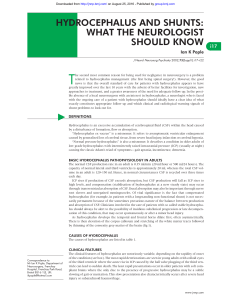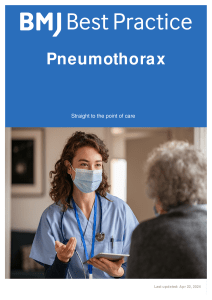Propaganda or the cost of innovation? Challenging the high price of
Anuncio
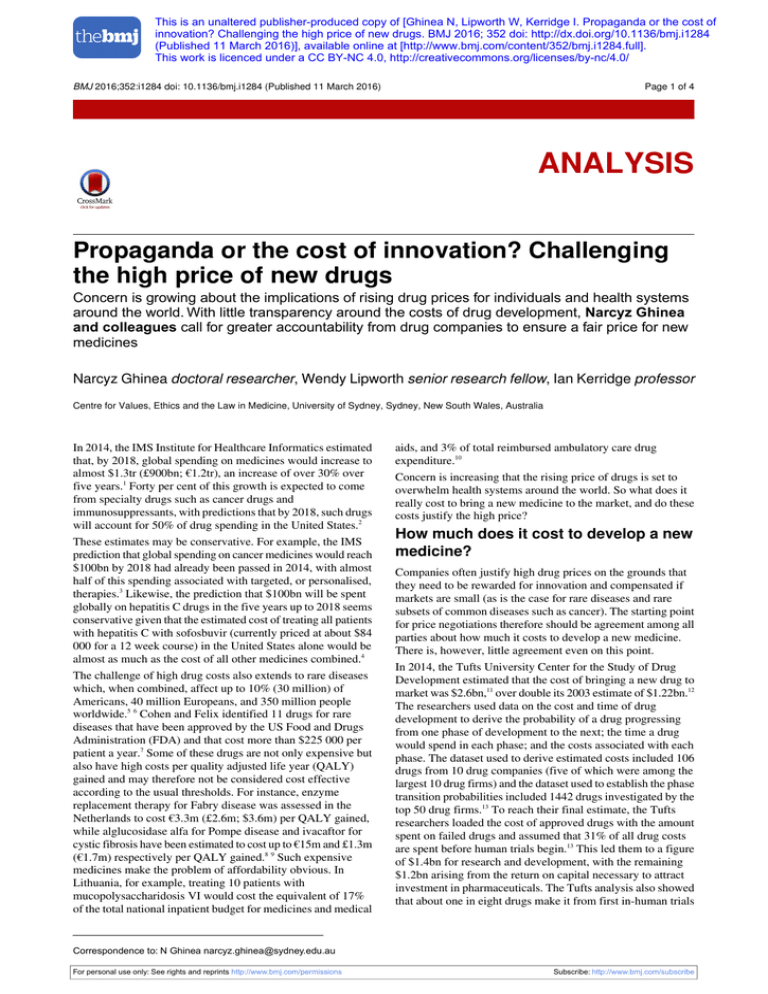
This is an unaltered publisher-produced copy of [Ghinea N, Lipworth W, Kerridge I. Propaganda or the cost of innovation? Challenging the high price of new drugs. BMJ 2016; 352 doi: http://dx.doi.org/10.1136/bmj.i1284 (Published 11 March 2016)], available online at [http://www.bmj.com/content/352/bmj.i1284.full]. This work is licenced under a CC BY-NC 4.0, http://creativecommons.org/licenses/by-nc/4.0/ BMJ 2016;352:i1284 doi: 10.1136/bmj.i1284 (Published 11 March 2016) Page 1 of 4 Analysis ANALYSIS Propaganda or the cost of innovation? Challenging the high price of new drugs Concern is growing about the implications of rising drug prices for individuals and health systems around the world. With little transparency around the costs of drug development, Narcyz Ghinea and colleagues call for greater accountability from drug companies to ensure a fair price for new medicines Narcyz Ghinea doctoral researcher, Wendy Lipworth senior research fellow, Ian Kerridge professor Centre for Values, Ethics and the Law in Medicine, University of Sydney, Sydney, New South Wales, Australia In 2014, the IMS Institute for Healthcare Informatics estimated that, by 2018, global spending on medicines would increase to almost $1.3tr (£900bn; €1.2tr), an increase of over 30% over five years.1 Forty per cent of this growth is expected to come from specialty drugs such as cancer drugs and immunosuppressants, with predictions that by 2018, such drugs will account for 50% of drug spending in the United States.2 These estimates may be conservative. For example, the IMS prediction that global spending on cancer medicines would reach $100bn by 2018 had already been passed in 2014, with almost half of this spending associated with targeted, or personalised, therapies.3 Likewise, the prediction that $100bn will be spent globally on hepatitis C drugs in the five years up to 2018 seems conservative given that the estimated cost of treating all patients with hepatitis C with sofosbuvir (currently priced at about $84 000 for a 12 week course) in the United States alone would be almost as much as the cost of all other medicines combined.4 The challenge of high drug costs also extends to rare diseases which, when combined, affect up to 10% (30 million) of Americans, 40 million Europeans, and 350 million people worldwide.5 6 Cohen and Felix identified 11 drugs for rare diseases that have been approved by the US Food and Drugs Administration (FDA) and that cost more than $225 000 per patient a year.7 Some of these drugs are not only expensive but also have high costs per quality adjusted life year (QALY) gained and may therefore not be considered cost effective according to the usual thresholds. For instance, enzyme replacement therapy for Fabry disease was assessed in the Netherlands to cost €3.3m (£2.6m; $3.6m) per QALY gained, while alglucosidase alfa for Pompe disease and ivacaftor for cystic fibrosis have been estimated to cost up to €15m and £1.3m (€1.7m) respectively per QALY gained.8 9 Such expensive medicines make the problem of affordability obvious. In Lithuania, for example, treating 10 patients with mucopolysaccharidosis VI would cost the equivalent of 17% of the total national inpatient budget for medicines and medical aids, and 3% of total reimbursed ambulatory care drug expenditure.10 Concern is increasing that the rising price of drugs is set to overwhelm health systems around the world. So what does it really cost to bring a new medicine to the market, and do these costs justify the high price? How much does it cost to develop a new medicine? Companies often justify high drug prices on the grounds that they need to be rewarded for innovation and compensated if markets are small (as is the case for rare diseases and rare subsets of common diseases such as cancer). The starting point for price negotiations therefore should be agreement among all parties about how much it costs to develop a new medicine. There is, however, little agreement even on this point. In 2014, the Tufts University Center for the Study of Drug Development estimated that the cost of bringing a new drug to market was $2.6bn,11 over double its 2003 estimate of $1.22bn.12 The researchers used data on the cost and time of drug development to derive the probability of a drug progressing from one phase of development to the next; the time a drug would spend in each phase; and the costs associated with each phase. The dataset used to derive estimated costs included 106 drugs from 10 drug companies (five of which were among the largest 10 drug firms) and the dataset used to establish the phase transition probabilities included 1442 drugs investigated by the top 50 drug firms.13 To reach their final estimate, the Tufts researchers loaded the cost of approved drugs with the amount spent on failed drugs and assumed that 31% of all drug costs are spent before human trials begin.13 This led them to a figure of $1.4bn for research and development, with the remaining $1.2bn arising from the return on capital necessary to attract investment in pharmaceuticals. The Tufts analysis also showed that about one in eight drugs make it from first in-human trials Correspondence to: N Ghinea narcyz.ghinea@sydney.edu.au For personal use only: See rights and reprints http://www.bmj.com/permissions Subscribe: http://www.bmj.com/subscribe BMJ 2016;352:i1284 doi: 10.1136/bmj.i1284 (Published 11 March 2016) Page 2 of 4 ANALYSIS to market, and that it takes about 30 years for a drug to reach market, a substantial portion of which is in preclinical research. The Tufts estimate has, however, been extensively criticised for ignoring charitable and public spending contributions to drug development.14 15 Kantarjian and Rajkumar estimate that 85% of basic research into cancer drugs is taxpayer funded.16 And others, such as Harvard pharmacoepidemiologist Jerry Avorn, have suggested that the Tufts researchers overstated the returns that investors require and ignored the massive untaxed cash reserves that drug companies could use to invest in research.15 A further problem with the Tufts estimate is lack of transparency about the drugs selected for the analysis. We do not know, for example, how many were submitted through accelerated approval programmes, how many were new biological compounds, how many were treatments for rare diseases, and to what extent research and development was supported by public funding. Tufts’ estimate (which is actually conservative compared with some others17) is therefore unlikely to allay concerns that drug companies’ profits vastly outweigh the risks they take. The industry as a whole makes profits 3-37 times higher than other industries, with the largest companies making profits of 30%, yet it invests less in research and development than similar research dependent industries.18 19 Furthermore, roughly twice as much is spent on marketing than on innovation, and companies misleadingly include marketing costs in their assessments of expenditure on research and development.19 20 Alternative explanations for high costs of drugs While drug companies focus on the cost of development to justify high drug prices, there are several other explanations. Many of these arise from the fact that the pharmaceutical market is not actually a “free market” based on supply and demand with minimal government intervention through taxes, subsidies, or regulation.21 Rather, the market is highly manipulated, with numerous government programmes that create special pathways for product funding and may not be focused on achieving the best prices—or even fair prices—for drugs. In addition, the United State has pursued active deregulation through laws that have limited public payers’ ability to take advantage of price control strategies.22 This is important globally because the high prices charged in the United States can have a knock-on effect on the prices accepted by other countries.23 Generous intellectual property provisions also allow companies to set and maintain high prices for extended periods.24 Drug prices are driven up further through the industry “gaming” the system in various ways. For example, companies are able to maintain high prices through practices such as drug switching (discontinuing a cheaper drug to force uptake of more expensive alternatives),25 and “pay to delay” tactics, which reward competitors for delaying the launch of competing products.26 Drug companies may also launch similar brand name drugs to extend patent terms,27 aggressively fight generic competitors, and misuse legislation aimed at stimulating research into rare diseases to develop blockbuster (non-orphan) drugs and to extend their patents on existing products.28 There is also no doubt that some companies increase prices simply because they can. The recent attempt by Turing Pharmaceuticals to institute a 5000% price hike of pyrimethamine is a clear illustration of this point.29 Other examples include the more than 2000% increase in the price of the tuberculosis drug cycloserine after it was purchased by For personal use only: See rights and reprints http://www.bmj.com/permissions Rodelis Therapeutics; the 500% increase in price for the heart medication nitroprusside after it was purchased by Valeant Pharmaceuticals; and the more than 1200% increase in the price of naproxen and esomeprazole for management of pain since their purchase by Horizon Pharma.29 In the United States the price of cancer drug imatinib has increased more than threefold over a decade, even though the market has greatly increased.30 Until recently the burden of expensive medicines on health systems has gone largely unnoticed. This may be because the market is ignorant of what drugs really cost or that it consists of often desperate patients and their carers who are driven by hope and are relatively insensitive to cost.31 Drug prices may also be inflated by skewed incentive systems for funding doctors and hospitals.25 Varied approach to funding medicines In some countries, the cost of medicines is covered by public or private insurance schemes. In addition to centralised systems, special funds may be established, such as the Cancer Drugs Fund and Hepatitis C Fund in the UK, and the Herceptin Program and Life Savings Drugs Program in Australia.32-35 Some patients may also access medicines through expanded access or compassionate access programmes in which the drug industry provides drugs freely, or at a discount, to those who can’t afford them.33 Such schemes can increase access to high cost medicines, but they can also introduce inequities between and within countries because not all patients have equal access to these programmes.12-37 Special government funding schemes can also create enormous opportunity costs and may represent a form of price deregulation, where companies who have their products rejected as not cost effective can seek reimbursement through less stringent alternative mechanisms. For instance, the breast cancer drug eribulin was rejected by the UK National Institute for Health and Care Excellence at the lowest price offered in Europe, but it was subsequently covered through the UK Cancer Drugs Fund at a price that was among the highest in Europe.37 Concerns about idiosyncratic and inconsistent approaches to funding medicines have drawn attention to the importance of robust health technology assessment (HTA) processes, which are used to determine the cost effectiveness of new drugs, as well as to drug pricing and the implications this has for fair access to medicines. Can we find a “just” price for drugs? Although a thriving drug industry may be an economic and financial benefit to governments, the triumphs of pharmaceutical innovation are hollow victories if they cripple health systems and generate massive inequities. This raises the question: what is a “just” price to pay for new medicines? The question is not easy to answer because a ‘just’ price for a medicine would have to take account of, at a minimum, the costs of research and development (minus public and charitable contributions), regulatory unpredictability and attrition rates, the extent to which the medicine is innovative and meets a genuine unmet need, the likely market size, the cost of manufacturing, and affordability. Affordability, in turn, is contextual, and varies in terms of national gross domestic product, income per capita, and national healthcare budget. The just price for a medicine may therefore vary greatly between diseases and countries, and disagreement is likely even within a single setting. When decision criteria for setting prices cannot be predefined, it is important to ensure procedural justice, whereby all of the Subscribe: http://www.bmj.com/subscribe BMJ 2016;352:i1284 doi: 10.1136/bmj.i1284 (Published 11 March 2016) Page 3 of 4 ANALYSIS factors influencing a decision can be scrutinised by all stakeholders. One such framework is “accountability for reasonableness,” which emphasises public access to decisions and transparency about reasons for decisions; the need for these reasons to be relevant to “fair minded” participants; mechanisms to challenge or dispute decisions; and regulation of the process.38 In the case of drug pricing, successful implementation of such a framework would require much greater transparency and stakeholder inclusion than is currently the case. While full transparency and inclusiveness might not be realistic currently, payers and other key stakeholders should at least know for any given drug: • How much has been spent on research directly related to the development of the specific drug • How much has been spent on abandoned compounds that directly led to the development of the specific drug, and • How much it costs to manufacture each unit of product. For such a process to be workable, the industry will need to think beyond corporate confidentiality, fear of losing a competitive advantage, and perhaps, in some instances, fear of possible public backlash from revealing how much profit is made for specific drugs. At the same time, payers will need to respect commercial realities, avoid demanding prices that do not reflect the true cost of development, and provide fair commercial rewards (for example, acknowledging that for personalised medicines, smaller markets and difficulty attracting investment may necessitate higher per unit prices39). Some jurisdictions in the United States have attempted to pass transparency laws that would make such information available.40 In the absence of such laws, payers could encourage transparency by providing greater leeway in price negotiations to companies that do disclose costs, thereby putting pressure on competing companies to do the same. In addition, we propose using an indication specific pricing mechanism to take account of the fact that medicines approved for treating multiple diseases are unlikely to offer the same value across all indications.41 Better mechanisms are also needed of managing “indication creep” of high cost medicines and for discounting prices over time, especially once patents expire. 3 4 5 6 7 8 9 10 11 12 13 14 15 16 17 18 19 20 21 22 23 24 25 26 Price negotiations should not be stubbornly anti-industry. But equally, those negotiating drug prices can’t be held captive to industry demands for commercial confidentiality, to threats to abandon small markets if exorbitant prices are not accepted, or to unqualified appeals to the “free market.” 27 Contributors and sources: NG is a doctoral researcher focusing on ways of improving decision making processes around high cost cancer drugs. WL’s work focuses on the ethics of drug development and health technology assessment. IK has an international reputation in bioethics and the philosophy of medicine. 30 Competing interests: We have read and understood BMJ policy on declaration of interests and declare the following interests: all authors receive funding from the National Health and Medical Research Council. IK has previously been a member of the Royal Australasian College of Physicians Working Group that developed guidelines for interactions with industry. WL is affiliated with the Drug Information Association. Provenance and peer review: Not commissioned; externally peer reviewed. 1 2 IMS Institute for Healthcare Informatics. Global outlook for medicines through 2018. IMS, 2014. Johnson S, Gunderson B, Bowen K, Starner CI, Gleason PP. Specialty drugs are forecasted to be 50% of all drug expenditures in 2018. http://cdn2.content.compendiumblog. com/uploads/user/e7c690e8-6ff9-102a-ac6d-e4aebca50425/accf0d87-0d14-4aa7-bbf3- For personal use only: See rights and reprints http://www.bmj.com/permissions 28 29 31 32 33 34 35 36 37 38 39 193b90c8d68c/File/1f8476cb4a60eb472893ddf381c9c3ec/prediction_that_by_2018__ more_than_50_percent_of_all_drug_expenditures_will_be_specialty.pdf. IMS Institute for Healthcare Informatics. Developments in cancer treatments, market dynamics, patient access and value: global oncology trend report 2015. IMS, 2015. Senior M. Sovaldi makes blockbuster history, ignites drug pricing unrest. Nat Biotechnol 2014;32:501-2. doi:10.1038/nbt0614-501. .24911474. GlobalGenes. Rare diseases: facts and statistics. https://globalgenes.org/rare-diseasesfacts-statistics/. European Commission. European rare diseases day: top facts on EU action. Press release, 27 Feb 2014. http://europa.eu/rapid/press-release_MEMO-14-141_en.htm. Cohen JP, Felix A. Are payers treating orphan drugs differently?J Market Access Health Policy 2014;2:23513doi:10.3402/jmahp.v2.23513. . Simoens S, Picavet E, Dooms M, Cassiman D, Morel T. Cost-effectiveness assessment of orphan drugs: a scientific and political conundrum. Appl Health Econ Health Policy 2013;11:1-3. doi:10.1007/s40258-012-0004-y. 23329382. Cohen D, Raftery J. Paying twice: questions over high cost of cystic fibrosis drug developed with charitable funding. BMJ 2014;348:g1445. doi:10.1136/bmj.g1445. 24523379. Godman B, Malmström RE, Diogene E, et al. Are new models needed to optimize the utilization of new medicines to sustain healthcare systems?Expert Rev Clin Pharmacol 2015;8:77-94. doi:10.1586/17512433.2015.990380. 25487078. Tufts Centre for the Study of Drug Development. Cost to develop and win marketing approval for a new drug is $2.6 billion. Press release, 18 Nov 2014. http://csdd.tufts.edu/ news/complete_story/pr_tufts_csdd_2014_cost_study. Appleby J. The Cancer Drugs Fund: inequitable and inefficient? King’s Fund, 2014. http: //www.kingsfund.org.uk/blog/2014/09/cancer-drugs-fund-inequitable-and-inefficient. Tufts Centre for the Study of Drug Development. Briefing: cost of developing a new drug. 2014. http://csdd.tufts.edu/files/uploads/Tufts_CSDD_briefing_on_RD_cost_study_-_Nov_ 18,_2014.pdf. Doctors Without Borders. R&D cost estimates: MSF response to Tufts CSDD study on cost to develop a new drug. Press release, 18 Nov 2014. http://www.doctorswithoutborders. org/article/rd-cost-estimates-msf-response-tufts-csdd-study-cost-develop-new-drug. Avorn J. The $2.6 billion pill—methodologic and policy considerations. N Engl J Med 2015;372:1877-9. doi:10.1056/NEJMp1500848. 25970049. Kantarjian H, Rajkumar SV. Why are cancer drugs so expensive in the United States, and what are the solutions?Mayo Clin Proc 2015;90:500-4. doi:10.1016/j.mayocp.2015. 01.014. 25792242. Herper M. The truly staggering cost of inventing new drugs. Forbes 2012 Feb 10. http:// www.forbes.com/sites/matthewherper/2012/02/10/the-truly-staggering-cost-of-inventingnew-drugs/. Spitz J, Wickham M. Pharmaceutical high profits: the value of R&D, or oligopolistic rents?Am J Econ Sociol 2012;71:1-36. doi:10.1111/j.1536-7150.2011.00820.x. 22319815. World Health Organisation. Trade, foreign policy, diplomacy and health: pharmaceutical industry. 2015. http://www.who.int/trade/glossary/story073/en/ Angell M. The truth about the drug companies: how they deceive us and what to do about it. Random House, 2005. Investopedia. Definition of free market. http://www.investopedia.com/terms/f/freemarket. asp. Bach PB. Limits on Medicare’s ability to control rising spending on cancer drugs. N Engl J Med 2009;360:626-33. doi:10.1056/NEJMhpr0807774. 19176475. Toumi M, Remuzat C, Vataire AL, et al. External reference pricing of medicinal products: similation-based considerations for cross-country coordination. 2014. http://ec.europa.eu/ health/healthcare/docs/erp_reimbursement_medicinal_products_en.pdf. Lawson C. How are pharmaceutical patent term extensions justified? Australia’s evolving scheme. J Law Med 2013;21:379-98.24597388. Gatesman ML, Smith TJ. The shortage of essential chemotherapy drugs in the United States. N Engl J Med 2011;365:1653-5. doi:10.1056/NEJMp1109772. 22040130. Japsen B. AMA wants to stop pharma pay-to-delay tactic on generics. Forbes 2012 Nov 13. http://www.forbes.com/sites/brucejapsen/2012/11/13/ama-wants-to-stop-pharma-payto-delay-tactic-on-generics/ Moir H, Gleeson D. Explainer: evergreening and how big pharma keeps drug prices high. The Conversation 2014 Nov 6. http://theconversation.com/explainer-evergreening-andhow-big-pharma-keeps-drug-prices-high-33623. Wellman-Labadie O, Zhou Y. The US Orphan Drug Act: rare disease research stimulator or commercial opportunity?Health Policy 2010;95:216-28. doi:10.1016/j.healthpol.2009. 12.001. 20036435. Gilchrist A, Eder K. Turing Daraprim price hike follows a precedent. Pharmacy Times 2015 Sept 22. http://www.pharmacytimes.com/news/turing-daraprim-price-hike-followsa-precedent. Experts in Chronic Myeloid Leukemia. The price of drugs for chronic myeloid leukemia (CML) is a reflection of the unsustainable prices of cancer drugs: from the perspective of a large group of CML experts. Blood 2013;121:4439-42. doi:10.1182/blood-2013-03490003. 23620577. Lakdawalla DN, Romley JA, Sanchez Y, Maclean JR, Penrod JR, Philipson T. How cancer patients value hope and the implications for cost-effectiveness assessments of high-cost cancer therapies. Health Aff (Millwood) 2012;31:676-82. doi:10.1377/hlthaff.2011. 1300. 22492883. Cancer Research UK. Cancer drugs fund. 2015. http://www.cancerresearchuk.org/aboutcancer/cancers-in-general/cancer-questions/cancer-drugs-fund. Deloitte Access Economics. Access to cancer medicines in Australia: Medicines Australia Oncology Industry Taskforce. 2013. http://medicinesaustralia.com.au/files/2013/07/Accessto-oncology-medicines-1707-FINALV3.pdf. Adams B. NHS England sets up new 190, hep C fund. PMLIVE 2015 Jun 12. http://www. pmlive.com/pharma_news/nhs_england_sets_up_new_190m_hep_c_fund_755898. Department of Health. Other supply arrangements outside the pharmaceutical benefits scheme. 2015. http://www.health.gov.au/LSDP. Howell J. Opportunity cost of the cancer drug fund. BMJ 2011;342:d622doi:10.1136/bmj. d622. . Cancer Drug Fund: benign or malignant? The Economist 2015 Jan 24. http://www. economist.com/news/britain/21640343-well-meaning-gesture-causing-more-and-moretrouble-benign-or-malignant. Daniels N. Accountability for reasonableness. BMJ 2000;321:1300-1. doi:10.1136/bmj. 321.7272.1300. 11090498. Herper M. The world’s most expensive drugs. Forbes 2010 Feb 22. http://www.forbes. com/2010/02/19/expensive-drugs-cost-business-healthcare-rare-diseases.html. Subscribe: http://www.bmj.com/subscribe BMJ 2016;352:i1284 doi: 10.1136/bmj.i1284 (Published 11 March 2016) Page 4 of 4 ANALYSIS Key messages The cost of drugs, particularly new biological agents, is overwhelming health budgets around the world Little is known about how much it really costs to develop new medicines and, therefore, what they are really worth This limits the ability of public and private payers to negotiate affordable prices and show that they are achieving “value for money” Basic information about drug development costs needs to be available to both payers and the public to ensure greater accountability 40 41 Pollack A. Drug prices soar, prompting calls for justification. New York Times 2015 July 23. http://www.nytimes.com/2015/07/23/business/drug-companies-pushed-from-far-andwide-to-explain-high-prices.html. Bach PB. Indication-specific pricing for cancer drugs. JAMA 2014;312:1629-30. doi:10. 1001/jama.2014.13235. 25279433. For personal use only: See rights and reprints http://www.bmj.com/permissions Accepted: 08 02 2016 Published by the BMJ Publishing Group Limited. For permission to use (where not already granted under a licence) please go to http://group.bmj.com/group/rights-licensing/ permissions Subscribe: http://www.bmj.com/subscribe
